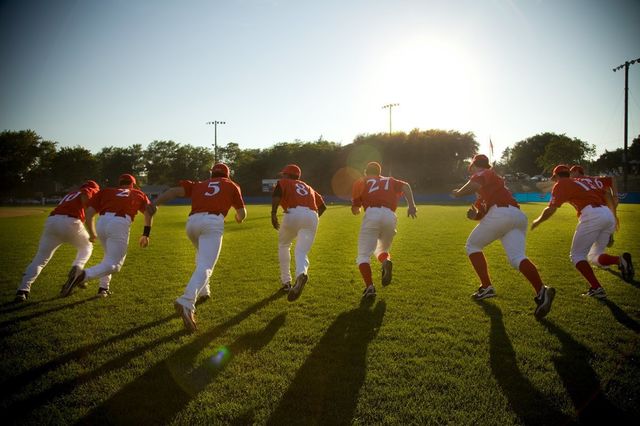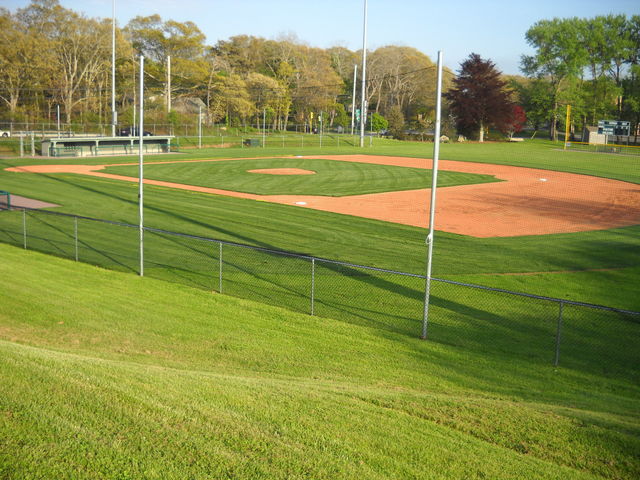

Sunny skies, salty air, freshly cut grass and crack, a bat connects with a ball. Cape Cod summer baseball season is in full swing. Year-round residents and seasonal visitors are likely to take in a game or two and enjoy the talent and sportsmanship of the players of the Cape Cod Baseball League or of our town-sponsored Babe Ruth and Little League teams. While watching pop flies, admiring stolen bases, and examining close umpire calls, most fans will not give a second thought to the actual field where the players earn their stats.

Tourists and locals alike gather every year to witness a Cape Cod tradition of exciting summer league baseball.
Long before opening day, a different team will stand on a wooded plot of land and envision a baseball field. At the top of the order are a civil engineer and a land surveyor who will walk the property, identify its limits, and examine the topography.
Also, early in the line-up, a landscape architect will consider the natural landscape of the property. His or her goal may include evaluation of the field location possibilities in order to preserve trees and natural, surrounding vegetation. A paramount determination will be the orientation of the field. Here in the northeast, the line of sight between home plate and the pitcher’s mound should face north to north-east to minimize sun in the eyes of the batters and the fielders. Subsequently, the landscape architect will develop a conceptual layout including access to the site and the actual playing field.

Here in the northeast, the line of sight between home plate and the pitcher’s mound should face north to north-east to minimize sun in the eyes of the batters and the fielders. Subsequently, the landscape architect will develop a conceptual layout including access to the site and the actual playing field.
The engineer will prepare detailed plans that show specifics on how to keep the field area well drained and will provide construction details including all of the necessary dimensions and measurements. Rounding out the batting order is a contractor who will implement the construction plans including clearing the property, constructing the playing field and other site improvements. The contractor will be assisted by the land surveyor who will place reference stakes that will guide the contractor in grading the land and executing the design.
From there, the designated hitters are the subcontractors who will install field amenities such as the dugouts, backstop, irrigation systems, and fencing. Depending on the size of the field, the entire project from concept to live pitching can range from about six months to two years. It is often advisable to allow the field to remain unused for a season to allow the grass to mature. The project timeline can be accelerated if artificial or sod turf is used rather than grass from seed.
Baseball fields are located in most towns across the Cape. Cape Cod Baseball League games can be seen weekly at Doran Park, Bourne; Guv Fuller Field, Falmouth; Lowell Park, Cotuit; Stony Brook School, Brewster; and Whitehouse Field, Harwich to name a few. The Orleans Firebirds’ home field is Eldredge Park, a field noteworthy for its cascade-style seating, band shell, and beautiful grounds.

Eldredge Park in Orleans, Massachusetts is a field noteworthy for its cascade-style seating, band shell, and beautiful grounds.
Fast forward to August. Thunderstorms have prevailed for days. Two of the Cape League’s best teams are scheduled for a 7:00 night game. Will the game be cancelled? Is the park flooded? Will the infield be covered with puddles of water? The answer is no, thanks in large part to the “players” who designed the field. The slope of the “skinned” infield was designed to angle down a little more than the grassy part of the infield. The slope of the outfield was set to allow water to drain off the playing surface but not permit runoff from adjacent land onto the field. Attention to detail while grading the infield area allows for the ball to “roll true” but not allow water to puddle. The engineer, surveyor, landscape architect, and contractor are like the coaching staff. Details abound, but because of this team’s specific skills and project experience, they collaborate to design a winning field.

The slope of the outfield was set to allow water to drain off the playing surface but not permit runoff from adjacent land onto the field. Attention to detail while grading the infield area allows for the ball to “roll true” but does not allow water to puddle.
Whether you’re a fan of the Y-D Red Sox, Brewster Whitecaps, Chatham Anglers, Harwich Mariners, or one of other wonderful local teams, the next time you attend a game, when the game is done and after the stands have emptied, take a good, long look at the field and appreciate the team that played there long before the first pitch was ever thrown.
Please contact Coastal Engineering Co., Inc. for a full review or with any specific questions you may have.